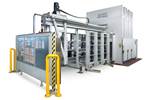Wickert press advances Chemnitz polymers, composites and metals research
Since its installation, the rapid heating/cooling press has become of great importance to the Institute for Lightweight Structures’ work in processing high-performance structural and hybrid components for industrial-scale applications.
The team led by Prof. Dr. Wolfgang Nendel (second from right) uses the new WKP 3000 S to investigate the use of high-performance thermoplastics, in particular PEEK and its derivatives. Source | Wickert
Since 2024, what Wickert (Landau, Germany) contends is the world’s fastest heating/cooling press has been in operation at the Institute of Lightweight Structures (IST), part of the Faculty of Mechanical Engineering at (Germany). With its high tempering speeds, the Wickert WKP 3000 S has been enabling the university scientists to process high-performance thermoplastics such as polyetheretherketone (PEEK) in record time.
The team, led by Prof. Dr. Wolfgang Nendel, is researching how structural components and hybrid components made of plastics, like fiber-reinforced composites, and metal can be manufactured using near-series production processes. Their focus is on structural components for aerospace, automotive and electromobility. Typical applications include tanks for hydrogen systems, battery carriers for electric vehicles, crash-relevant car parts for front- and rear-ends, and drainage and manhole systems for the construction industry.
Another field of research concerns thermoplastic carbon fiber-reinforced polymer (CFRTP) profiles for aircraft components. Chemnitz scientists are investigating how these high-performance materials can be processed in cost-effective, large-scale production. The focus here is on materials that can replace standard polymers such as PP and PE as well as engineering plastics such as PA, PC, POM and PET when they reach their performance limits. Wickert’s hydraulic press is helping them to achieve this.
The WKP 3000 S achieves peak temperatures of up to 450° C across the entire 600 × 600-millimeter pressing area. It currently delivers heating rates of 55 Kelvin/minute and cooling rates of up to 100 Kelvin/minute. The maximum deviation over the entire surface is less than 5°C.
In addition, the press reaches its full press force of 3,000 kilonewtons in under one second. The plane parallelism, less than 0.1 millimeter, and a maximum lateral offset of 0.02 millimeter enable processing with a high level of precision.
“The Wickert press — in particular, its extreme speeds of temperature control — have added value in [our] research,” Nendel says. “This allows us to design test series much more effectively and create many more samples in the shortest possible time.” A production cycle that takes a few minutes on the Wickert press would take over an hour on a normal press, for example.
Related Content
-
Plant tour: Daher Shap’in TechCenter and composites production plant, Saint-Aignan-de-Grandlieu, France
Co-located R&D and production advance OOA thermosets, thermoplastics, welding, recycling and digital technologies for faster processing and certification of lighter, more sustainable composites.
-
Plant tour: Sekisui Aerospace, Orange City, Iowa, Renton and Sumner, Wash., U.S.
Veteran composites sites use kaizen and innovation culture to expand thermoplastic serial production, 4.0 digitization and new technology for diversified new markets.
-
Thermoplastic composites: Cracking the horizontal body panel nut
Versatile sandwich panel technology solves decades-long exterior automotive challenge.






